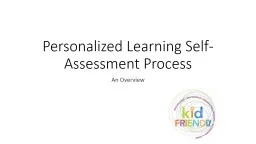

An Overview To know whether kidFRIENDLy is being successful we must gauge the extent to which schools are using key grant components to create meaningful personalized learning environments across ID: 392127
Download Presentation The PPT/PDF document "Personalized Learning Self-Assessment Pr..." is the property of its rightful owner. Permission is granted to download and print the materials on this web site for personal, non-commercial use only, and to display it on your personal computer provided you do not modify the materials and that you retain all copyright notices contained in the materials. By downloading content from our website, you accept the terms of this agreement.
Slide1
Personalized Learning Self-Assessment Process
An OverviewSlide2
To know whether
kid·FRIENDLy
is being successful, we must gauge the extent to which schools are
using key
grant components to create meaningful personalized learning environments across
multiple classrooms
.
This
self-assessment process is critical to knowing how much progress we’ve made,
and where
we go in the next two years of the grant
.Slide3
Self-Assessment as a Mechanism for Learning
Given that this
grant has
only been implemented for
two
years,
no school is expected to demonstrate the sustaining
level (
the highest rating) of personalized learning
, and certainly not on all components of the
Personalized Learning
Continuum
.
Likewise, schools have focused their efforts around specific innovations and may be utilizing
certain
kid·FRIENDLy
grant supports more than others. Therefore,
schools are also not expected to obtain
high ratings
on all dimensions of the Driver Implementation Continuum
.Slide4
Just as classroom teachers formatively assess
their students
so they can make adjustments in their instruction and give students descriptive feedback
for continuous
improvement
, this self-assessment process helps schools deepen their self-awareness
of their
strengths and growth areas and supports the on-going work of making learning more
personalized for
all students.Slide5
Note
Results of your school’s self-assessment will not be shared with any other school.
Schools will not be penalized or rewarded in any way for their self-assessment results.
This process solely serves the purpose of reflecting on your progress and planning for the future.Slide6
An Overview of the Process
Assemble a self-assessment team (p. 2)
Get familiar with two key rubrics:
The Driver Implementation Continuum (p. 3-4 and Appendix A)
The Personalized Learning Continuum (p. 4-6 and Appendix B)
Make an initial round of self-ratings (p. 6-7)
Consider evidence that would support or challenge your self-ratings (p. 7-9)
Make a final round of ratings (p. 9)
Reflect on the results (p. 9)Slide7
Self Assessment Team (p. 2)
School principal
1-3 other members of the school’s leadership team
1 or more teachersSlide8
5 Key Drivers (p. 3 and Appendix A)
Driver 1: Students as LeadersDriver 2: College and Career Readiness
Driver 3: Communities of Practice
Driver 4: Community-Based Child-care*
Driver 5: Communities of Learners
*Not included in the Driver Implementation ContinuumSlide9
The Driver Implementation Continuum (p. 3-4 and Appendix A)
For each driver, you will self-assess in the following 3 categories:
Participation in Grant Supported Activities
Knowledge of the kid-
FRIENDLy
and Personalized Learning Framework and key terms associated with the Driver
Knowledge of Performance MeasuresSlide10Slide11
Driver Implementation Continuum: Five Performance Levels (p. 3-4 and Appendix A)
Continuing the Status Quo
Starting
Implementing
Scaling Up
SustainingSlide12
Personalized Learning Continuum (App. B)
The Personalized Learning Continuum is based on research literature and well-established
theories about
student motivation and optimal learning environments (see
Bibliography).
The
Continuum presents a comprehensive framework for describing a school that
has created
sustainable structures and practices that foster student empowerment in the learning process
, fluidly
adjusting the pace and location of learning to meet the student at his or her individual
readiness level
.Slide13
Personalized Learning Continuum:
4 Standards
The Continuum is divided into four standards which represent key perspectives on
personalized learning
. Schools that are truly
personalized
will differ dramatically from traditional schools relative
to the
learning process
, the overall
school climate
(which requires a
change
in leadership perspective
and behavior
), and in the attitudes and activities of
teachers
and
students
.Slide14
Reminder: The process
Assemble teamGet familiar with the continuum documents
Make initial round of ratings and compare
Consider evidence to support, challenge, or clarify your ratings
Make a final round of ratingsSlide15
Evidence Sources
Evidence will be especially important if
your
initial
ratings are high
for particular areas on one or both continuums, if
individual ratings
are inconsistent
from member to member, or to
substantiate areas rated high on the team’s
final consensus
ratings
(Step 6).
Sources
might include a
review of
artifacts
(p. 7),
interviews
with select groups
of teachers
or
students (p. 8 and Appendixes C and D),
and
observations
of select
classrooms (p. 8 and Appendix E).Slide16
Final Ratings and Reflect on Results (p. 9 and Appendix F)
Make sure all team members can review various sources of evidence and then make a final round of ratings (electronic).
Use Appendix F to reflect on results – Plus, Delta, Next Steps.
Email to
rocksolid@wku.edu
:
Driver Implementation Continuum final ratings
Personalized Learning Continuum final ratings
Reflection and Planning Tool (Appendix F)Slide17
A Final Note
Thank
you for the time you
devote
to this self-assessment process.
Your efforts will pay off
in terms
of better understanding your school’s progress toward personalized learning and how
grant leaders
can better support your work
.
Questions? Please email
rocksolid@wku.edu